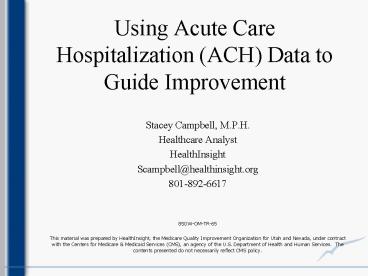Using Acute Care Hospitalization ACH Data to Guide Improvement
1 / 20
Title:
Using Acute Care Hospitalization ACH Data to Guide Improvement
Description:
This material was prepared by HealthInsight, the Medicare ... Grooming. Dressing upper body. Dressing lower body. Bathing. Toileting. Transferring. Ambulation ... –
Number of Views:40
Avg rating:3.0/5.0
Title: Using Acute Care Hospitalization ACH Data to Guide Improvement
1
Using Acute Care Hospitalization (ACH) Data to
Guide Improvement
- Stacey Campbell, M.P.H.
- Healthcare Analyst
- HealthInsight
- Scampbell_at_healthinsight.org
- 801-892-6617
- 8SOW-OM-TR-65
- This material was prepared by HealthInsight, the
Medicare Quality Improvement Organization for
Utah and Nevada, under contract with the Centers
for Medicare Medicaid Services (CMS), an agency
of the U.S. Department of Health and Human
Services. The contents presented do not
necessarily reflect CMS policy.
2
Purpose of Training
- Explain purpose and importance of Risk-Adjustment
methods - Provide insight on how to use available data to
guide improvement efforts - Improving assessment skills will lead to
- Better Documentation of Patient Risk Factors
- Better Care Plans
- Better Performance Scores
3
The ACH Measure
- GOAL Decrease the percentage of avoidable
hospitalizations - Numerator All patients with a hospital admission
(MO8551) - Denominator All patients
- Exclusions All patients who died or had a
non-responsive level of consciousness at start of
care - Risk Adjusted
4
Risk Adjustment
- Risk Factor Patient level factor that may
influence outcome (e.g., Hospitalization) - Risk Adjustment Statistical compensation for
risk factors among samples so that a valid
comparison can be made - Not all agencies have similar patient populations
-risk-adjustment allows for fair comparison of
rates - OASIS used for this adjustment of risk factors!!
5
Some of the Risk Factors
- Age
- Gender female
- Any Medicare payment source
- Patient resides in own home
- Patient lives alone
- Patient lives with family member
- Patient has unpaid live-in help
- Presence of a primary caregiver
- ADL assistance provided by caregiver
- IADL assistance provided by caregiver
- Frequency of caregiver assistance
- Inpatient discharge from hospital
- Inpatient discharge from rehab. facility
- Inpatient discharge from nursing home
- Medical regimen change
- Prior condition Urinary incontinence
- Prior condition Catheter
- Prior condition Intractable pain
- Prior condition Impaired decision-making
- Severity rating of primary diagnosis
- Maximum diagnosis severity rating
- Number of severity ratings gt 2
- Moderate recovery prognosis
- Good rehabilitation prognosis
- High risk factors
- Smoking Obesity Alcohol Drugs
- Activities of daily living (ADL) disabilities
- SOC/ROC
- Grooming
- Dressing upper body
- Dressing lower body
- Bathing
- Toileting
- Transferring
- Ambulation
- Eating
6
What Can We Do With These Data???
- Understand
- Look deeper
- Interpret the information
- Act on it!
7
Understanding the Data
- The risk-adjusted rate provides you with
information on your status compared to everyone
else in the nation - What does it mean to you? Not enough without
additional information - Other numbers to look at
- Observed rate
- Census
8
Looking Deeper into the Data
- The observed rate actual percentage of patients
with a hospitalization (No risk adjustment) - Questions to ask yourself
- Is there a drastic difference between the rates?
- Is your patient population very different?
- Are the hospitalizations occurring in a
particular population?
9
Difference Between Observed and Risk-Adjusted
Rates
- Lower observed rates indicate the patient
population is less sick or at risk than the
national norm - Lower risk-adjusted rates indicate the patient
population is sicker and has a higher risk for
the specified outcome - Improving intake assessments and documentation
will improve risk-adjusted rates
10
(No Transcript)
11
Interpreting the Information
- Are our patients really not as sick as those
treated by other agencies? - DOCUMENTATION! Provide a complete picture of the
patients health - What processes do we need to change? Event tree
is a very useful tool in determining faulty
processes - Are we misinterpreting the cause of
hospitalizations or playing too much of a blame
game? - Dont guess or assume use the data available to
you.
12
Now that youve interpreted the data, you can
choose the right way to ACT ON IT!
13
Risk Profiles
- Calculated using the OASIS
- Documentation of patient health status on the
intake assessment is directly related to the risk
adjustment on ACH rates - Chronic Disease Assessment skills training
provided by Bob Ferry
14
Outcome Measures
- MO400 Hearing and ability to understand spoken
language. Increase in percentage of patients gt
1 - MO410 Speech and oral expression of Language.
Increase in percentage of patients gt 1 - MO420 Frequency of pain. Increase in
percentage of patients with gt 2 -
continued
15
Outcome Measures
- MO490 Dyspnea. Increase in percentage of
patients gt 2 - MO530 Urinary incontinence. Increase in
percentage of patients gt1 - MO560 Cognitive functioning. Increase in
percentage of patients gt 1 - MO570 Confusion. Increase in percentage of
patients gt 1 continued
16
Outcome Measures
- MO580 Anxiety. Increase in percentage of
patients gt 2 - MO590 Depression. Increase in percentage of
patients with more than 1 symptom - MO610 Behaviors demonstrated. Increase in
percentage of patients with more than 1 behavior
17
Risk Score
- Patients categorized as 0 or 1 for each of the 10
outcome measures - The ten values are added together for each
patient - All patient values are averaged to get an agency
risk score - As proficiency in completing the intake
assessment improves, the risk score should
increase
18
Example of Risk Profile Report
19
Results from Accurate Risk Assessments
- Better care for patients
- Higher reimbursement (MO420, MO490, MO530, MO610)
- BETTER ACH RATES!
20
Summary
- Data are not just numbers
- You create your data!
- Improve your data, improve knowledge of your
data, and you can improve your performance































